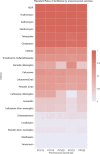Distribution of serotypes and antibiotic resistance profiles of Streptococcus pneumoniae in hospitalized adult patients: aretrospective multicenter surveillance in China (2018-2019)
- PMID: 40764912
- PMCID: PMC12323133
- DOI: 10.1186/s12879-025-11377-5
Distribution of serotypes and antibiotic resistance profiles of Streptococcus pneumoniae in hospitalized adult patients: aretrospective multicenter surveillance in China (2018-2019)
Abstract
Background: Streptococcus pneumoniae (S. pneumoniae) remains a major cause of community acquired pneumonia (CAP), particularly among older adults. In China, pneumococcal infections pose a substantial disease burden, with rising antibiotic resistance. Although vaccines have effectively reduced disease worldwide, data on adult serotype distribution and resistance in China are scarce. This study investigates serotype patterns and antimicrobial susceptibility of S. pneumoniae among Chinese adults.
Methods: We collected a total of 474 S. pneumoniae isolates from adult patients diagnosed with pneumococcal infections in 14 cities across five geographic regions of China between 2018 and 2019. Clinical specimens included sputum, blood, bronchoalveolar lavage fluid (BALF), cerebrospinal fluid (CSF), pharyngeal and nasal swabs, and middle ear fluid. Minimum inhibitory concentrations (MICs) of antimicrobial agents were determined using the agar dilution method. Pneumococcal serotyping was performed using the Pneumotest-Latex kit and type-specific antisera.
Results: Serotype 19F was the most prevalent across all age groups, specimen types, and regions. 20-valent pneumococcal conjugate vaccine (PCV20) is expected to provide the highest serotype coverage (69.4%) among all vaccines evaluated. Multidrug resistance was detected in over 94% of isolates, with high resistance to macrolides, tetracycline, and clindamycin. β-lactam resistance varied by syndrome and region. Non-invasive isolates showed slightly higher resistance than invasive ones. Serotypes covered by higher-valency vaccines were more likely to be antibiotic-resistant, although fluoroquinolone and vancomycin resistance remained low.
Conclusions: Our findings highlight a high burden of antimicrobial resistance and predominance of specific serotypes, particularly 19F, among adult S. pneumoniae isolates in China. The broad serotype coverage of PCV20 suggests its potential advantage in future adult immunization strategies. Continued surveillance of serotype distribution and resistance patterns is essential to inform vaccine policy and guide effective antibiotic use.
Keywords: Streptococcus pneumoniae; Adult; Antimicrobial resistance; China; PCV20; Pneumococcal conjunctive vaccine; Serotype.
© 2025. The Author(s).
Conflict of interest statement
Declarations. Ethics approval and consent to participate: The study protocol was approved by the Ethics Committee of Peking University People’s Hospital (approval No. 2018PHB129) and conducted in accordance with the principles of the Declaration of Helsinki. Informed consent was waived due to the retrospective nature of the study and the use of anonymized data, as approved by the Institutional Review Board of Ethics Committee of Peking University People’s Hospital. Consent for publication: Not applicable. Competing interests: The authors declare no competing interests.
Figures






Similar articles
-
Changes in serotype distribution and antimicrobial nonsusceptibility of Streptococcus pneumoniae among hospitalized children: Shenzhen, China, 2009-2019.Expert Rev Vaccines. 2025 Dec;24(1):624-634. doi: 10.1080/14760584.2025.2531898. Epub 2025 Jul 14. Expert Rev Vaccines. 2025. PMID: 40632624
-
Serotype distribution and antibiotic resistance of Streptococcus pneumoniae isolates from 17 Chinese cities from 2011 to 2016.BMC Infect Dis. 2017 Dec 29;17(1):804. doi: 10.1186/s12879-017-2880-0. BMC Infect Dis. 2017. PMID: 29284419 Free PMC article.
-
Serotype distribution and antimicrobial susceptibility pattern in children≤5years with invasive pneumococcal disease in India - A systematic review.Vaccine. 2017 Aug 16;35(35 Pt B):4501-4509. doi: 10.1016/j.vaccine.2017.06.079. Epub 2017 Jul 12. Vaccine. 2017. PMID: 28711387
-
Whole-genome sequencing, strain composition, and predicted antimicrobial resistance of Streptococcus pneumoniae causing invasive disease in England in 2017-20: a prospective national surveillance study.Lancet Microbe. 2025 Jul;6(7):101102. doi: 10.1016/j.lanmic.2025.101102. Epub 2025 May 24. Lancet Microbe. 2025. PMID: 40425021
-
Streptococcus pneumoniae serotype 19A in Latin America and the Caribbean: a systematic review and meta-analysis, 1990-2010.BMC Infect Dis. 2012 May 28;12:124. doi: 10.1186/1471-2334-12-124. BMC Infect Dis. 2012. PMID: 22639955 Free PMC article.
References
-
- Yu X, Wang H, Ma S, Chen W, Sun L, Zou Z. Estimating the global and regional burden of lower respiratory infections attributable to leading pathogens and the protective effectiveness of immunization programs. Int J Infect Dis. 2024;149:107268. - PubMed
-
- Kang L, Jing W, Liu Q, Liu J, Liu M. The trends of mortality, aetiologies and risk factors of lower respiratory infections in China from 1990 to 2019: findings from the Global Burden of Disease Study 2019. J Infect Public Health. 2022;15(8):870–6. - PubMed
Publication types
MeSH terms
Substances
LinkOut - more resources
Full Text Sources
Medical
Miscellaneous

